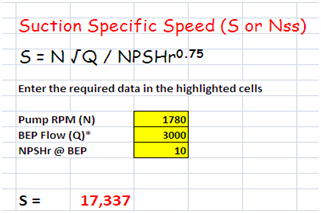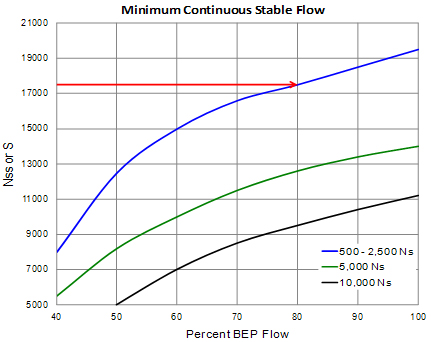In the February 2010 issue of Pumps & Systems, I wrote an article on my Excel-based Suction Specific Speed and Suction Energy calculators and how they can be used to predict the onset of suction recirculation. During the past year, I have received several requests to revisit this topic and its application to wastewater pumps.
Clear Water Impellers
Clear water impellers are usually designed for high efficiency, but they can also be designed for low NPSHr. Increasing the eye diameter decreases the inlet velocity and, therefore, reduces the NPSH required to maintain uniform flow. It is this reduction in inlet velocity that causes the NPSHr to drop as flow moves to the left of a typical H/Q curve and when the rotational speed of the same pump is reduced.
These impeller designs can work well as long as flow remains at or near the best efficiency point (BEP). If flow moves too far to the left of BEP, the increased peripheral velocity of the larger eye distorts the flow into the inlet and directs a portion of the flow back out of the impeller (suction recirculation). During recirculation, intense vortices arise and cause low pressure areas that will lead to cavitation and severe pressure pulsations. The effect of the impeller eye diameter on potential suction recirculation can be evaluated using suction specific speed (S or Nss).
Suction Specific Speed
Igor Karassik and two of his associates, G.F. Wislicenus and R.M. Watson, developed suction specific speed (S) in 1937 during their tenure at Worthington Pump. It is a dimensionless number that describes the suction conditions that occur due to the relationship of rotational speed, flow and NPSHr. Its development overcame the limitations of the Thoma-Moody constant, which attempted to describe suction conditions by relating head to NPSHr.
S can range from about 5,000 to over 20,000 and is computed by the equation
![]()
Where:
N is the rotational speed
Q is BEP flow
NPSHr is the NPSHr at BEP
Several pump organizations including the Hydraulic Institute (HI) and American Petroleum Institute (API) recommend an S of under 10,000 to maintain a reasonable range of flows without the potential for suction recirculation.
Wastewater Impellers
Wastewater pump impellers are not intentionally designed for low NPSHr, but the relatively large eye required to pass solids can often lower their NPSHr and increase the value of S. The H/Q curves for some higher flow wastewater pumps show a continuous increase in NPSHr as flow moves to the left of BEP. This is exactly the opposite of the NPSHr versus flow for clear water pumps with normal eye diameters. In the case of wastewater pumps, discharge recirculation at the vane exits can also increase the possibility of suction recirculation. This is due to the lack of any vane overlap on most wastewater impellers, which results in the onset of discharge recirculation at higher flows than expected. For more information on suction and discharge recirculation, see Igor Karassik's three part series “Centrifugal Pump Operation at Off-Design Conditions. It is available on the “Other Pump Topics” page of www.PumpEd101.com.
Figure 1 shows the S calculation for an 8-inch, 1,780-rpm wastewater pump with a BEP flow and head of 3,000 gallons per minute at 135 feet and a specific speed (Ns) of 2,450. BEP efficiency and NPSHr are 82 percent and 10 feet. The calculated value for S is 17,337.

Figure 1. Suction specific speed calculation for a wastewater pump
Figure 2 shows the minimum continuous stable flow (MCSF) for pumps with a given Ns and S. MCSF is the flow at which the onset of suction recirculation can begin. The Y axis is S and the X axis is percent of BEP flow. The three curves represent various pump Ns. Note that MCSF is dependent upon both Ns and S.

Figure 2. Minimum continuous stable flow
The example in this column has an Ns of 2,450, so the upper curve will be used. The red horizontal line at Y = 17,337 intersects the curve at X = 80 percent. Therefore, this pump could potentially begin suction recirculation when the flow drops to just 80 percent of BEP flow. If the suction energy ratio (Pumps & Systems, February 2010) of this pump is examined, an NPSHa to NPSHr margin of 4.0 could be required to provide stable operation at or below 80 percent of BEP flow.
Many higher flow pumps with relatively low values of S can still exhibit an increase in NPSHr as flow is reduced. For example, the performance curve for an 18-inch by 16-inch wastewater pump (Ns= 2,735) with a BEP flow of 16,000 gallons per minute at 200 feet shows an NPSHr of 31 feet. The calculated value of S is 11,072, which predicts an MCSF of approximately 50 percent. However, at 13,000 gallons per minute (a flow reduction of just 19 percent), the NPSHr, as shown on the curve, increases to 44 feet.
Submersible Wastewater Pumps
Submersible wastewater pumps can be especially problematic. Although some undergo comprehensive NPSHr testing, many are not tested at all. Others are tested at BEP only, and NPSHr values are calculated at other flow points. Often it is assumed that the additional inlet pressure provided by submersion will provide adequate NPSH.
Actually, submersion offers no NPSH advantage since pumps installed in dry pits also have a similar level of submersion due to the water level in the wet well. Submersibles do have one advantage, and that is lower inlet losses due to no inlet piping and fittings. This, of course, goes away when they are installed in a dry pit submersible application.
If the manufacturer does not provide NPSHr data, how can end users identify potentially problematic submersible pumps? There is no perfect way, but what I do is compare untested pumps with similar ones from other manufacturers that have been tested at multiple flow points. To get a good comparison, end users need to compute the Ns of the untested pump and compare it to tested pumps with the same or similar Ns, rotational speed, hydraulic efficiency, eye diameter ratio, flow and head.
Here are some rules of thumb. S is directly proportional to rotational speed and the square root of flow. Therefore, higher speed and higher flow pumps will more likely have higher values of S. I have found that most 1,750-rpm pumps with 4-inch discharges and flows under 800 gallons per minute will have an S under 10,000, and 1,750-rpm pumps with 6-inch discharges and flows under 1,750 gallons per minute have similar values of S. However, as the eye diameter ratio of either approaches 0.6, S can exceed 13,000. If an end user plans to run a wastewater pump to the left of BEP and NPSHr is not part of the test curve, he should get the manufacturer to sign off on the application.
Pumps & Systems, November 2011
Click here for a Readers Response to this article.

